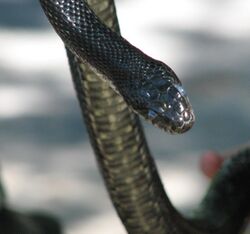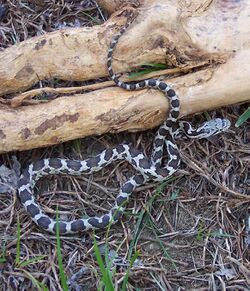Biology:Pantherophis alleghaniensis
| Eastern ratsnake | |
|---|---|

| |
| Adult eastern ratsnake Murphys Point Provincial Park, Ontario | |
| Scientific classification | |
| Domain: | Eukaryota |
| Kingdom: | Animalia |
| Phylum: | Chordata |
| Class: | Reptilia |
| Order: | Squamata |
| Suborder: | Serpentes |
| Family: | Colubridae |
| Genus: | Pantherophis |
| Species: | P. quadrivittatus
|
| Binomial name | |
| Pantherophis quadrivittatus | |
| Synonyms | |
| |
Pantherophis alleghaniensis, commonly called the eastern rat snake, is a species of nonvenomous snake in the family Colubridae. The species is endemic to North America.[10][11]
Common names
Additional common names for P. alleghaniensis include black rat snake, pilot snake, pilot black snake,[11] chicken snake; and in Florida, yellow rat snake and Everglades rat snake.[12]
Geographic range

P. alleghaniensis is found in the United States east of the Apalachicola River in Florida, east of the Chattahoochee River in Georgia, east of the Appalachian Mountains, north to southeastern New York and western Vermont, eastern Pennsylvania, Maryland, South Carolina, North Carolina, Georgia, south to the Florida Keys.[10][11][12][13][14] In the Florida Panhandle, it readily hybridizes with the gray rat snake (Pantherophis spiloides).[12]
Description

Adult eastern rat snakes commonly measure 90 to 183 cm (2 ft 11 in to 6 ft 0 in) in total length (including tail), with a few exceeding 200 cm (6 ft 7 in).[12] The longest recorded total length to date for an eastern rat snake is 228 cm (7 ft 6 in).[11] A sample of eastern rat snakes, including juvenile and adult snakes, weighed from 54 g (1.9 oz) to 1,274 g (2.809 lb).[15] A further adult weighed 833 g (1.836 lb).[16]
Adults are shiny black dorsally, with a cream or white chin and throat. White areas of skin can appear between scales.[17] The belly has an irregular black and white checkerboard pattern, becoming uniformly slate gray towards the tail. Juveniles have 28 to 40[18] dark dorsal blotches on a grayish ground color. The ventral pattern in juveniles is the same as in adults. The eyes are round with a black pupil, and particularly in juveniles but not always present in adults, a distinct white margin.[11][13]
In cross section, the bodies of rat snakes are not round, but instead resemble a loaf of bread.[19]
The dorsal scales are weakly keeled, and are arranged in 23 to 27 rows at midbody.[20]
Males and females have the same coloration. Males have proportionally longer tails (16–19% of total body length) compared to females (14–18% of total body length).[11]
Habitat
The eastern rat snake occurs in a variety of habitats. These include farmlands, hardwood forests, forested wetlands, thickets and fields adjacent to forests, isolated urban woodlots and backyards that support populations of prey species. The eastern rat snake does especially well in early successional and edge habitats. An arboreal species, it can get into human residences, where it may live in attics undetected. At the northern limits of its range, distribution appears to be restricted by the availability of suitable hibernating sites. In these climates, it requires southern exposures to receive maximal thermal benefit from the winter sun and to provide basking areas in early spring and late fall.[11][13] In one study tracking habitat conditions, eastern rat snakes were found to exhibit site fidelity; returning to the same location for 12% of observations.[21] The three U.S populations located more northerly (Illinois at 378N, Kansas at 388, Maryland at 398) hibernate, with very rare appearances before April and after October. In most northern locations latitudinal and longitudinal effects are likely because of thermal restriction or modification of activity associated with winter temperatures at higher temperatures.[22] There are consequences of thermal constraints regarding ecological parameters such as causes of variation of seasonal mortality, population demography, limits to geographic distribution, and the expression or evolution of traits such as habitat selection, reproductive allocation, and mechanisms of physiological hibernation remain complex and incompletely understood.[22]
Behavior and ecology
The eastern rat snake is primarily active at night during the summer, and diurnal in the spring and fall.[23] It is a terrestrial burrower and an excellent climber, and it may enter water. It is found under rocks and boards, and in trees under bark and within knot holes and palm fronds. Eastern rat snakes have been found using water filled cavities in trees, with many using the cavities at the same time. Gravid females were also four times more likely to use the water cavities than non-gravid females or male ratsnakes. [24] The snake is a constrictor, and adults eat mainly endotherms while young eat mainly ectotherms. The diet includes rodents, lizards, frogs, and birds and their eggs.[25] The snakes can also eat young chickens and chicks, hence the common name chicken snake.
Rat snakes are most vulnerable to predators as juveniles. Predators of P. alleghaniensis include hawks (Buteo spp.), great horned owls (Bubo virginianus), foxes, raccoons, and domestic cats. Adult eastern rat snakes have few known predators other than humans. When frightened, a rat snake will freeze. If harassed, it will produce a foul-smelling musk to deter predators. If provoked further, it may coil, shake its tail, and snap at its attacker.[26]
Eastern rat snakes hibernate during the winter underground or in deep crevices. They may congregate in the same dens with other species of snakes, such as copperheads (Agkistrodon contortrix), eastern racers (Coluber constrictor) and timber rattlesnakes (Crotalus horridus). In Northern climes, the snakes are active from late April to October and mate in May or June. It is active earlier in the South.[27]
Reproduction
Eastern rat snakes reach sexual maturity in their fourth year. The snakes start to breed in May and June, earlier in the South. Males approach females to initiate breeding and may combat other males before breeding. About five weeks after mating, the female lays 5 to 27 eggs in hollow standing and fallen trees, compost and mulch heaps, sawdust piles, and decomposing logs. Incubation is about two months, and eggs hatch from July through September. Hatchlings are usually just over a foot long at birth, with the distinct gray and black pattern characteristic of juveniles.[23][26][27]

Taxonomy
P. alleghaniensis has sometimes been considered a subspecies of P. obsoletus, to which it is closely related.[28]

This species has often been placed in the genus Elaphe, but recent phylogenetic analyses have resulted in its transfer to Pantherophis.[29][30][31]
References
- ↑ Hammerson GA (2007). "Pantherophis obsoletus ". The IUCN Red List of Threatened Species 2007: e.T63864A12715740. https://dx.doi.org/10.2305/IUCN.UK.2007.RLTS.T63864A12715740.en. Downloaded on 30 July 2016.
- ↑ Cite error: Invalid
<ref>tag; no text was provided for refs namedHolbrook1836 - ↑ Baird SF, Girard C (1853). Catalogue of North American Reptiles in the Museum of the Smithsonian Institution. Part I.—Serpents. Washington, District of Columbia: Smithsonian Institution. https://archive.org/details/catalogueofnorth00bair. xvi + 172 pp. (Scotophis alleghaniensis, new combination, p. 73).
- ↑ Hallowell E (1856). "Notice of a collection of reptiles from Kansas and Nebraska, presented to the Academy of Natural Sciences by Dr. Hammond". U.S.A. Proc. Acad. Nat. Sci. 8: 238–253. https://www.biodiversitylibrary.org/bibliography/6885. (Elaphis alleghaniensis, new combination, p. 243).
- ↑ Garman S (1892). The Discoboli. Cyclopteridæ, Liparopsidæ, and Liparididæ. Cambridge, MA: Museum of Comparative Zoology at Harvard College. ISBN 978-1176120228. https://www.biodiversitylibrary.org/item/48648.
- ↑ Boulenger GA (1894). Catalogue of the Snakes in the British Museum (Natural History). Volume II., Containing the Conclusion of the Colubridæ Aglyphæ. London: Trustees of the British Museum (Natural History). (Taylor and Francis, printers). xi + 382 pp. + Plates I-XX. (Coluber obsoletus, pp. 50-51).
- ↑ Stejneger L, Barbour T (1917). A Check List of North American Amphibians and Reptiles. Cambridge, Massachusetts: Harvard University Press. 125 pp. (Elaphe obsoleta, p. 83).
- ↑ Burbrink FT (2001). "Systematics of the eastern ratsnake complex (Elaphe obsoleta)". Herpetological Monographs 15: 1–53. doi:10.2307/1467037.
- ↑ Collins, Joseph T.; Taggart, Travis W. (2008). "An alternative classification of the New World Rat Snakes (genus Pantherophis [Reptilia: Squamata: Colubridae)"]. Journal of Kansas Herpetology 26: 16–18. http://www.cnah.org/khs/khs_pubs/JKH_26.pdf.
- ↑ 10.0 10.1 10.2 "Pantherophis alleghaniensis " (PDF). Zoological Museum Hamburg. http://reptile-database.reptarium.cz/species?genus=pantherophis&species=alleghaniensis.
- ↑ 11.0 11.1 11.2 11.3 11.4 11.5 11.6 "Eastern Ratsnake: Pantherophis alleghaniensis ". Westborough, MA. http://www.mass.gov/eea/docs/dfg/nhesp/species-and-conservation/nhfacts/pantherophis-alleghaniensis.pdf.
- ↑ 12.0 12.1 12.2 12.3 "Pantherophis alleghaniensis ". Gainesville, FL. http://www.flmnh.ufl.edu/herpetology/fl-snakes/list/pantherophis-alleghaniensis.
- ↑ 13.0 13.1 13.2 "Field Guide to Maryland's Snakes (Order Squamata): Eastern Ratsnake". Annapolis, MD. http://dnr2.maryland.gov/wildlife/Pages/plants_wildlife/herps/Squamata.aspx?SnakeName=Eastern+Ratsnake.
- ↑ Powell R, Conant R, Collins JT (2016). Peterson Field Guide to Reptiles and Amphibians of Eastern and Central North America, Fourth Edition. Boston and New York: Houghton Mifflin Harcourt. xiv + 494 pp. ISBN:978-0-544-12997-9. (Pantherophis alleghaniensis, pp. 384-385 + Plate 36 + Figures 161, 180).
- ↑ Penning DA, Moon BR (2017). '"The king of snakes: performance and morphology of intraguild predators (Lampropeltis) and their prey (Pantherophis)". Journal of Experimental Biology 220 (6): 1154-1161.
- ↑ Veilleux J, Dombrowski DS, Allender MC, Lewbart G (2020). "Diagnosis, treatment and post‐release monitoring of an eastern black rat snake (Pantherophis alleghaniensis) with ophidiomycosis and traumatic injuries". Veterinary Record Case Reports 8 (2): e000954.
- ↑ "Black Ratsnake". https://www.marshall.edu/herp/Snakes/Black_Ratsnake.htm.
- ↑ "Black Ratsnake". https://www.marshall.edu/herp/Snakes/Black_Ratsnake.htm.
- ↑ "Black Ratsnake". https://www.marshall.edu/herp/Snakes/Black_Ratsnake.htm.
- ↑ Pantherophis alleghaniensis at Pennsylvania Herp Identification. http://www.paherps.com/herps/snakes/rat_snake.
- ↑ Howze, Jennifer M.; Sash, Kimberly J.; Carroll, John P.; Smith, Lora L. (2019-01-15). "A regional scale assessment of habitat selection and home range of the eastern rat snake in pine-dominated forests" (in en). Forest Ecology and Management 432: 225–230. doi:10.1016/j.foreco.2018.09.018. ISSN 0378-1127. https://www.sciencedirect.com/science/article/pii/S0378112718309526.
- ↑ 22.0 22.1 Ferguson GW (2020). "Seasonal Activity and Population Fluctuations of a Free-Ranging Population of the Rat Snake Pantherophis obsoletus Inhabiting the Dallas Zoo, Texas". The Southwestern Naturalist 64 (3-4, Southwestern Association of Naturalists, 2020): 173–79. doi:10.1894/0038-4909-64.3-4.173. https://doi.org/10.1894/0038-4909-64.3-4.173..
- ↑ 23.0 23.1 Behler, John L.; King, F. Wayne (1979). National Audubon Society Field Guide to North American Reptiles and Amphibians. Audubon Society Field Guide Series. New York, NY: Knopf Doubleday Publishing Group. ISBN 978-0394508245. https://archive.org/details/audubonsocietyfi00behl.
- ↑ Cerreta, Anthony J.; Cannizzo, Sarah A.; Smith, Dustin C.; Minter, Larry J. (2020-02-14). "Venous hematology, biochemistry, and blood gas analysis of free-ranging Eastern Copperheads (Agkistrodon contortrix) and Eastern Ratsnakes (Pantherophis alleghaniensis)". PLOS ONE 15 (2): e0229102. doi:10.1371/journal.pone.0229102. ISSN 1932-6203. http://dx.doi.org/10.1371/journal.pone.0229102.
- ↑ "Pantherophis alleghaniensis ". http://explorer.natureserve.org/servlet/NatureServe?searchName=Pantherophis+alleghaniensis.
- ↑ 26.0 26.1 "Black Rat Snake". Baltimore, MD. http://www.marylandzoo.org/animals-conservation/reptiles/black-rat-snake/.
- ↑ 27.0 27.1 "Eastern Ratsnake (Pantherophis alleghaniensis)". http://www.virginiaherpetologicalsociety.com/reptiles/snakes/eastern-ratsnake/blackrat_snake.php.
- ↑ Pantherophis . SSARHerps.
- ↑ Utiger U, Helfenberger N, Schätti B, Schmidt C, Ruf M, Ziswiler V (2002). "Molecular Systematics and Phylogeny of Old and New World ratsnakes, Elaphe Auct., and related genera (Reptilia, Squamata, Colubridae)". Russian Journal of Herpetology 9 (2): 105–124. http://vipersgarden.at/PDF_files/PDf-352.pdf.
- ↑ "How and when did Old World ratsnakes disperse into the New World?". Molecular Phylogenetics and Evolution 43 (1): 173–189. 2007. doi:10.1016/j.ympev.2006.09.009. PMID 17113316.
- ↑ Pyron RA, Burbrink FT (2009). "Neogene diversification and taxonomic stability in the snake tribe Lampropeltini (Serpentes: Colubridae)". Molecular Phylogenetics and Evolution 52 (2): 524–529. doi:10.1016/j.ympev.2009.02.008. PMID 19236930.
Further reading
- Holbrook JE (1836). North American Herpetology; or, A Description of the Reptiles Inhabiting the United States. Vol. I. Philadelphia: J. Dobson. 120 pp. (Coluber alleghaniensis, new species, pp. 111–112 + Plate XX).
- Jan G, Sordelli F (1867). Iconographie générale des Ophidiens: Vingt-quatrième livraison. Paris: Baillière. Index + Plates I-VI. (Elaphis alleghaniensis, Plate II, Figure 1 [adult], Figure 2 [juvenile]). (in French).
External links
| Wikimedia Commons has media related to Pantherophis alleghaniensis. |
- Pantherophis alleghaniensis at the Reptarium.cz Reptile Database. Accessed 29 November 2008.
Wikidata ☰ Q3362474 entry

